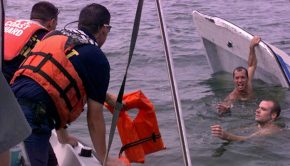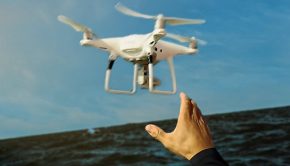Drone Regulation Remains Inconsistent
Published on April 19th, 2016
Drones are becoming an increasing popular and practical tool to share competitive sailing, but attempts at creating laws to regulate them have been inconsistent across the country and worldwide, a University of San Diego professor concluded in a new study.
“To date, drone legislation remains scattered and inconsistent, appearing in fits and spurts as legislative bodies at all levels debate what they are dealing with and how to respond to new technology in the minds of the general public,” wrote Austin Choi-Fitzpatrick, assistant professor of political sociology with the Joan B. Kroc School of Peace Studies at USD.
“Up in the Air,” the report he wrote with his students, was released this week.
The study focused on the increasing use of drones for recreational and other nonviolent uses worldwide. The report does not conclude with any specific recommendation, but does identify some consensus among entities struggling to figure out how they should be regulated.
“The legislative trends tend to be how large a device could be, where they can fly, how high they can fly, and that they should be registered,” he said.
The general consensus is that drones should be under a couple of pounds. “They’re getting smaller and smaller and easier to fly, meaning the old regulations don’t work,” he said. “The regulations before were that you had to be a military contractor.”
Choi-Fitzpatrick said restrictions on size, altitude and flights around airports and sensitive areas seem reasonable. So does asking people to register their drones, which at present is voluntary, he said.
The voluntary registration, which only recently was made possible by the Federal Aviation Administration, has created an awkward scenario for hobbyist, as only those who have complied face any kind of sanctions for violating rules.
“We found that a tremendous amount of use between 2014-2015 was everyday use,” Choi-Fitzpatrick said. “Usually, just anonymous folks. How they’re going to find those folks is very difficult to explain. But they certainly can go after people who are registered.”
With no actual law to back restrictions, Choi-Fitzpatrick said the FAA has relied on intimidating cease and desist letters to people known to fly drones commercially.
Rules on drones vary from state to state and internationally. Denmark and Malta allow larger drones than other countries, for example, while Sweden has adopted rules that take the kinetic energy of the drone into account.
Many countries have set a flight ceiling of 400 feet for drones. Portugal, however, sets the limit at 500 feet, while South Africa forbids them from flying higher than the tallest building or tree. In the United States, 12 laws restrict the use of drones by law enforcement, 10 restrict or criminalize unconsented drone surveillance, six restrict or ban hunting with a drone, five deal with the expansion of state legislative task force powers on drone use and four law prohibit drones from harming others or from flying over critical infrastructure facilities.
Choi-Fitzpatrick said Poway is the only local city he knows of that has created a specific law restricting drone flights. As explained in the report, the city’s director of safety has the authority to ground drones during emergencies.
To read the full report… click here.
Source: Gary Warth/Union Tribune









 We’ll keep your information safe.
We’ll keep your information safe.